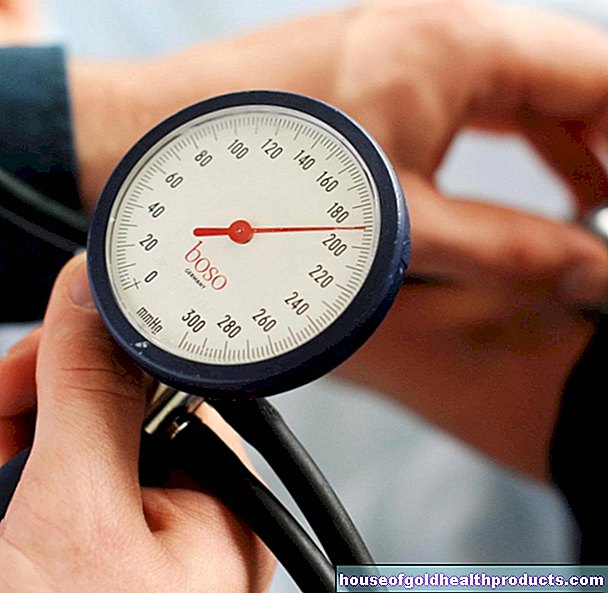Acid-base balance
and Martina Feichter, medical editor and biologistValeria Dahm is a freelance writer in the medical department. She studied medicine at the Technical University of Munich. It is particularly important to her to give the curious reader an insight into the exciting subject area of medicine and at the same time to maintain the content.
More about the expertsMartina Feichter studied biology with an elective subject pharmacy in Innsbruck and also immersed herself in the world of medicinal plants. From there it was not far to other medical topics that still captivate her to this day. She trained as a journalist at the Axel Springer Academy in Hamburg and has been working for since 2007 - first as an editor and since 2012 as a freelance writer.
More about the experts All content is checked by medical journalists.
The acid-base balance is a complex interaction of different systems with which the body ensures a constant pH value in the body. Excessive deviations are corrected with the help of several so-called buffer systems in the blood.Find out here what the acid-base balance can tell you about your health.
What is the acid-base balance?
The acid-base balance (sometimes just called the base balance) is made up of various buffer systems and ensures that the body can regulate fluctuations in the pH value in a targeted manner. This means: If the pH value is too low (acidic), bases are absorbed or formed and acids are eliminated. If the pH value is too high (basic or alkaline), on the other hand, acids are absorbed or formed and bases are eliminated.
Open and closed buffer systems
It is important to differentiate between open and closed buffer systems. Open buffer systems are able to transport excess acids or bases out of the body. The most important here is the bicarbonate buffer system, in which acidic substances can be exhaled through the lungs as carbon dioxide (CO2). The ammonium buffer system, on the other hand, excretes acids via the kidneys.
In contrast, with closed buffer systems, all acidic and basic substances remain in the body. But by binding them to other substances, the body can also regulate the pH value in this way. In the protein buffer system, for example, the red blood pigment (hemoglobin) or the blood protein albumin absorb the acidic hydrogen ions (H +).
When is the acid-base balance determined?
The doctor usually determines the acid-base balance via the pH value of the blood. Together with the other blood gas values - oxygen (O2), carbon dioxide (CO2), base excess (BE) and bicarbonate (HCO3) - he gets an overview of the performance of the lungs, the heart and the buffer systems. Kidney disorders also affect the acid-base balance and are reflected in changed measured values.
It is particularly important that the doctor correctly interprets the cause of a deviation in the pH value. A distinction is made between disorders that originate in the metabolism (metabolic disorders) and those that originate in the lungs (respiratory disorders). The system that is still functioning tries to normalize the pH value again. For example, the lungs intervene in the event of a metabolic disorder.
Acid-base balance - normal values
In order to determine the blood gas values and thus also the acid-base balance, the doctor usually takes a small blood sample from an artery. To assess the acid-base balance, the pH value, the partial pressure of the carbon dioxide (pCO2), the standard bicarbonate (HCO3) and the base excess (BE) are used in particular. The excess of base indicates whether there are too many or too few basic substances in the blood. The following normal values apply to adults:
|
parameter |
Normal range |
|
PH value |
7,36 – 7,44 |
|
pCO2 value |
35-45 mmHg |
|
Standard bicarbonate (HCO3-st.) |
22-26 mmol / l |
|
Excess base |
-2 to +2 mmol / l |
The values must always be assessed in conjunction with the reference values of the respective laboratory, which is why deviations are possible. Other normal values apply to children and adolescents.
When are the values of the acid-base balance too low?
If the doctor measures pH values that are too low, one speaks of acidosis. This means that the body is not able to convert acidic substances or to expel them via the lungs or kidneys, for example. The measured values for the carbon dioxide partial pressure, the bicarbonate and the excess base help to find the cause:
Put simply, carbon dioxide increases when the cause is respiratory in nature (respiratory acidosis). This is the case with restricted breathing (hypoventilation), for example due to a lung disease such as asthma.
On the other hand, if the bicarbonate level is too low, it is metabolic acidosis. In most cases, so-called ketoacidosis due to derailed type 1 diabetes mellitus is the cause. However, the proportion of acid also increases during fasting or in the event of a functional disorder of the kidneys (renal insufficiency).
In the worst case, both the carbon dioxide and the bicarbonate are increased. With this combined acidosis, the body is no longer able to regulate the pH level itself. The cause can be a multiple organ failure.
When are the values of the acid-base balance too high?
An increased pH value suggests alkalosis. The proportion of bases in the blood is too high, which is also reflected in an increased base excess.
In alkalosis, carbon dioxide and bicarbonate behave in exactly the opposite way as in acidosis. If the cause is respiratory, the carbon dioxide is decreased, if the cause is metabolic, the bicarbonate is increased. Excessive breathing (hyperventilation) in the event of stress, disorders of kidney function and severe vomiting can lead to alkalosis.
What to do if the acid-base balance changes?
In most cases, the body can help itself through the buffer systems in the blood. If not, different measures are taken to normalize the pH value, depending on the cause.
Especially in the case of severe disorders or very sick patients, the cause must be found and treated quickly. In the case of hyperventilation, for example, it can be helpful to let the patient breathe in and out into a bag. If the acid-base balance is changed due to a metabolic imbalance in diabetes (ketoacidosis), the patient needs a lot of fluids and the blood sugar-lowering hormone insulin.
Tags: Diagnosis menopause Menstruation





























